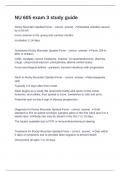NU 605 exam 3 study guide
Rocky Mountain Spotted Fever - correct answer ✔Rickettsia rickettsii caused
by a tick bit
most common in the spring and summer months
incubation 2-14 days
Symptoms Rocky Mountain Spotted Fever - correct answer ✔Fever 104 in
98% of children
Chills, myalgias, severe headache, malaise, GI upset/tenderness, diarrhea,
cough, conjunctival injection, photophobia, altered mental status
Focal neurological deficits - paralysis, transient deafness with progression
Rash in Rocky Mountain Spotted Fever - correct answer ✔Maculopapular
rash
Typically 2-5 days after fever onset
Rash begins as a small, flat nonpruritic faintly pink spots on the wrists,
forearms, and ankles, then spread to trunk, sometimes to sole and arms
Petechial rash on day 6 sign of disease progression.
Diagnosis for Rocky Mountain Spotted Fever - correct answer ✔Gold
standard is IFA on paired serologic samples taken in the first week and 2 to 4
weeks later. Antibody titer may be absent in the first 7 to 10 days
The fastest available test is PCR or immunohistochemical staining
Treatment for Rocky Mountain Spotted Fever - correct answer ✔Start within
5 days of symptoms due to possible false negative to prevent death
Doxycycline all ages 7 to 10 days
,children less than 100lbs 2.2mg/kg per dose twice daily
children greater than 100lbs 100mgs twice daily
Anisocoria - correct answer ✔unequal pupil size
myopia - correct answer ✔nearsightedness - can see near objects but not far
objects
strabismus - correct answer ✔defect in ocular alignment or the position of
the eyes in relation to each other (commonly called lazy eye)
one or both eyes can be appeared cross
Clinical findings strabismus - correct answer ✔´Intermittent exotropia (eye
turned outward) in normal children 6 months to 4 years, when tired, ill,
´Child fixates with unaffected eye
´Angle of deviation may change in different fields of gaze
´Persistent squinting, head tilting, face turning, nystagmus, overpointing,
awkwardness, marked decrease in acuity in one eye
´Cataracts, Retinoblastoma, anisometropia, severe refractive errors infrequent
Diagnostic techniques for strabismus - correct answer ✔´Diagnostic
techniques-photo screener can be used
´Corneal light reflection
´Cover-uncover test and alternating cover test
Management for strabismus - correct answer ✔´Refer to ophthalmologist if
>4 months and misalignment
´Occlusion of unaffected eye (2 hours/day)
,´Corrective lenses, corrective surgery
´Monitor siblings
´Local botulinum toxin injections may be used
Complications of strabismus - correct answer ✔´Secondary visual loss
occurs in 30-50% of kids with strabismus
amblyopia - correct answer ✔´Amblyopia - unilateral deficit with defect in
visual pathways for central vision
´Deprivational - obstruction of vision
´Strabismic - lazy eye
´Refractive - myopia, hyperopia, astigmatism, and anisometropia
´Clear focused images fail to reach brain; reduced or permanent vision loss
Clinical findings amblyopia - correct answer ✔´Clinical findings
´Squinting, fatigue, headaches (rare), pain, dizziness, nausea, developmental
delay, positive family history
Management of amblyopia - correct answer ✔´Management
´Refer for eye exam/prescription lenses
´Annual exam if wearing glasses
´Unilateral vision occlusion may be necessary
Complications and Prevention for amblyopia - correct answer ✔´Untreated
amblyopia results in irreversible loss
leukocoria - correct answer ✔white pupillary reflex seen in retinoblastoma
, refer to ophthalmologist
blepharoptosis - correct answer ✔´Ptosis - drooping of one or both upper
eyelids
´Congenital, trauma to CN III, trauma to eyelid or neck, chronic inflammation,
neurologic disorder
management for blepharoptosis - correct answer ✔´Refer to ophthalmologist
´Treat underlying systemic disease
´Evaluate for anisometropia (unequal refractive error)
´Evaluate for anisocoria (unequal pupil size)
´Evaluate for decreased pupillary light reflex
Surgery if vision is compromised, levator muscle
hordeolum - correct answer ✔´Stye - infection of sebaceous glands, eyelids,
or meibomian glands usually by staph aureus
clinical findings of hordeolum - correct answer ✔Tender, swollen furuncle on
external or internal lid margin
management of hordeolum - correct answer ✔´Spontaneous rupture
common, removal of eyelash
´Warm, moist compresses 3-4 x a day
´Cleanse the eye lid with no tears shampoo diluted 50%
´Anti-staphylococcal ointment- Emycin 0.5%
´Steroids not indicated
´Refer for incision and drainage if it does not rupture or multiple




